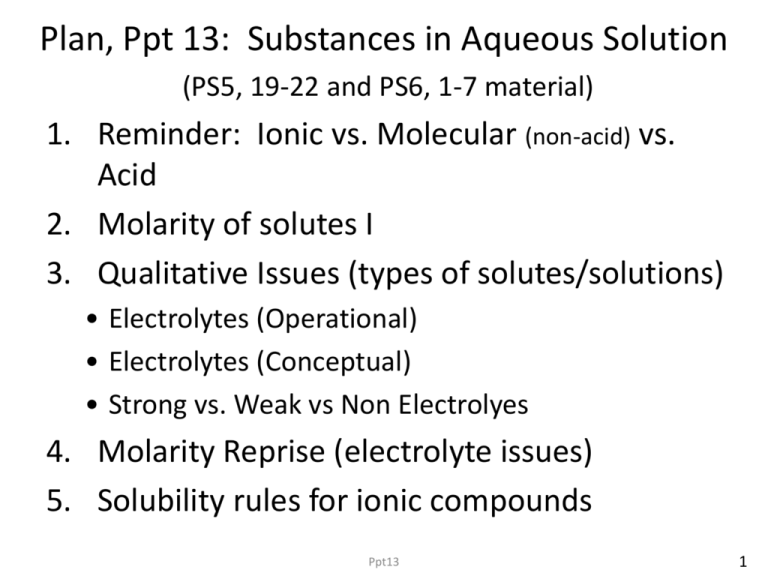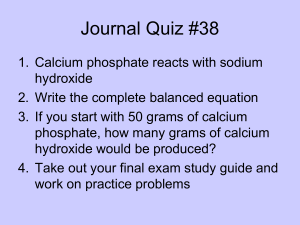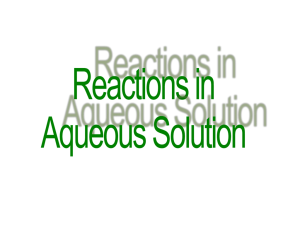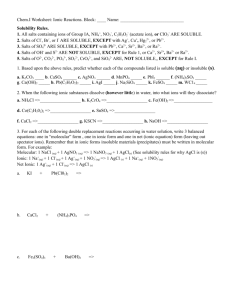Determining an Empirical Formula (summary)
advertisement

Plan, Ppt 13: Substances in Aqueous Solution (PS5, 19-22 and PS6, 1-7 material) 1. Reminder: Ionic vs. Molecular (non-acid) vs. Acid 2. Molarity of solutes I 3. Qualitative Issues (types of solutes/solutions) • Electrolytes (Operational) • Electrolytes (Conceptual) • Strong vs. Weak vs Non Electrolyes 4. Molarity Reprise (electrolyte issues) 5. Solubility rules for ionic compounds Ppt13 1 Reminder—Ionic Compounds • Metal or “NH4” listed first in formula • Made up of ions (cation and anion type) • You need to be able to: - Write the formulas of the cation and anion - State the number of each ion present in one FU of the compound • Example: Na3PO4 - Made up of Na+ ions and PO43- ions - 3 Na+ ions / FU; 1 PO43- / FU KNOW YOUR IONS!! (PS3) • NOTE: NaOH, KOH, etc. are ionic compounds. Because of the OH- ion (not the cation!), these ionic compounds are also called “bases”. Ppt13 2 Reminder—Molecular Compounds • In this class, a compound that is not ionic! • NO metal first; a nonmetal (unless “NH4”) • Learned to name binary molecular compounds… Non-acids (e.g., sulfur trioxide, SO3), and (binary) acids (e.g., hydrochloric acid, HCl) • …and one class of ternary molecular compounds (ternary) acids (e.g., chloric acid, HClO3) • But there are many other kinds Organic compounds: o C6H12O6 (glucose); CH3COCH3 (acetone); C8H8O4 (aspirin); most drugs, actually Ppt13 3 Reminder—Acids (a subset of molecular compounds) • H is listed first in formula (for acids in this class [simple]) • Made up of molecules, BUT…. • …can be thought of as being made by taking any anion and adding H+’s until a neutral FU results: - H+’s & PO43- H3PO4 (phosphoric acid) - H+’s & S2- H2S (hydrosulfuric acid) KNOW YOUR (AN)IONS!! (PS3) • You need to be able to: - Determine the anion from which the acid is derived • H+ is often called a “proton” (since an H atom has 1 p and 1 e-; if you remove the e-, you get H+ [1 p only]) Ppt13 4 A solution is a homogeneous mixture • Solvent is often a liquid • Solute is “what’s dissolved in” the liquid – Solute can be solid, liquid, or gas at room temp. – Solute can be a molecular compound (non-acid or acid), or an ionic compound • If solvent is water, solution is called “aqueous” [indicated by (aq) after solute] – E.g., NaCl(aq) • Dissolution is what happens as a solute dissolves in a liquid Ppt13 5 Operational Definition, Dissolution • Dissolution: Formation of a homogeneous mixture (a “solution”) – one substance “dissolves” in another – A “solution” is something you can see through (it is clear, not cloudy) You can assess • Is milk a solution? “dissolution” • Remember the “waviness” in lab visually. – If something “dissolves” in a liquid (to any appreciable extent), it is said to be soluble. • Some substances are soluble in water, some insoluble Ppt13 6 “Theory” note: Warning: Dissolution is not the same thing as Dissociation!! • Discussion of “dissociation” will come shortly. • For now just note that dissociation refers to a process that occurs after dissolution. – As such, in contrast to dissolution: You cannot assess “dissociation” visually. Ppt13 7 Molarity (Worksheet) Try these now! a) If 3.12 g of KF is dissolved in some water to make the final volume equal to 50.0 mL, what is the molarity of this solution? • (using P.T. info: MM of KF = 58.10 g/mol) b) How many moles of sugar (C6H12O6) are in 5.4 L of a 0.15 M solution? c) How many liters of a 2.5 M solution of KBr will contain 3.6 moles of KBr? PS5, problems19-21 reflect this material Ppt13 8 NOTE: Once molarity is understood, stoichiometry problems can utilize it! • “Another way to get to moles” (mol/L x L) • “Another way to go from moles” (mol L = M) • PS6, Q2; Question (d) on Molarity Worksheet: Plan: mL HCl L HCl mol HCl mol Na2O g Na2O Plan: mL HCl L HCl mol HCl mol Na2O M Na2O Ppt13 9 NOTE: Once molarity is understood, stoichiometry problems can utilize it! • More example problems of this type will be shown and discussed in Ppt 16b (as a summary application of ideas—titration as an application of stoichiometry with molarity) Ppt13 10 Back to the qualitative discussion of solutions Ppt13 11 Some solutes form solutions that conduct electricity and some do not! Operational Definition of “Electrolyte” • Electrolyte: a substance that is soluble in water and produces a solution with increased electrical conductivity – **Can test with a light bulb apparatus or conductivity meter** • By definition, electrolytes are a subset of all soluble substances. – All electrolytes are soluble, but not all soluble substances are electrolytes!! • Soluble substances that do not produce a solution with increased electrical conductivity are nonelectrolytes Ppt13 12 Some examples Electrolytes All soluble ionic compounds e.g., NaCl, NaNO3, FeCl3, NiSO4, Ca(OH)2, etc. All Acids and Molecular Bases: e.g., HCl, HNO2, HClO4, NH3, etc. Nonelectrolytes Most soluble molecular substances that are not acids or bases • CH3COCH3 (acetone) • CH3OH (methanol) • O2 • C12H22O11 (sucrose) Ppt13 13 Conceptual Definition of Electrolyte (theory) • Electrical current is “moving charge” – Need to have “mobile charges” to increase electrical conductivity • Electrolyte: a substance for which at least some of its dissolved formula units end up turning into ions – Process is called dissociation(or “ionization”) – Ions in solution are free to move around, hence increasing electrical conductivity! Ppt13 14 What happens during dissolution? (theory) • See next slide for pics that show the following: – Molecules will separate from one another, but generally remain intact (if substance dissolves) • Too small to scatter light, that’s why solution is “clear” – Ions will separate from one another once dissolved (if substance dissolves) • Too small to scatter light, that’s why solution is “clear” • Ionic compounds that dissolve will also undergo dissociation Ppt13 15 Dissolution only PS6, problem 3 reflects this material Dissolution & dissociation **Note that molecules remain intact during dissolution; they just separate from one another (without dissociating)! **Note that each individual cation (Na+) and anion (SO32-) remain intact during dissolution, but the ions separate from one another Dissolution is not the same as Dissociation (reprise) • Dissolution applies to any substance that dissolves, whether molecular or ionic • Dissociation (in aqueous solution) applies only to electrolytes; it refers to the production of ions in solution, after FUs dissolve. Recall: You cannot assess “dissociation” visually. Need “light bulb” or conductivity meter. Ppt13 17 Dissolution ≠ Disscociation (continued) • Most molecular substances’ FUs do not dissociate after they have dissolved – I.e., Most molecular substances are not electrolytes • But FUs of ionic compounds that dissolve DO also dissociate – I.e., Soluble ionic compounds are electrolytes Ppt13 18 Electrolytes come in two “types” • “strong”: ~100% of dissolved FUs are ionized • “weak”: significantly less than 100% are ionized • NOTE: “nonelectrolyte” refers to a soluble substance that is not an electrolyte – Thus an insoluble substance is technically neither a strong, weak, nor nonelectrolyte Ppt13 19 Analogous to Fig. 4.14 in Tro. Comparison of Strong, Weak, and Nonelectrolyte solutions (operationally and conceptually) All three substances are SOLUBLE, but they differ in the fraction of FUs that exist as separated ions: Strong electrolyte Weak electrolyte Nonelectrolyte (a) 100% of FUs are ionized (b) only a small fraction of FUs are ionized (c) NONE are ionized Ppt13 20 The Six Common Strong Acids (memorize) • HCl • HBr • HI • HNO3 • H2SO4 • HClO4 All others are weak acids! • HF • HNO2 PS5, problem 22 reflects this • H3PO4 material • H2CO3 • HClO • HC2H3O2 • Etc. 22 Ppt13 Analogous to Figure 4.10 in Tro. Polar Water Molecules Interact with the Positive and Negative Ions of a Salt Assisting in Dissolution (and Dissociation!!) Ppt13 23 NaCl Dissolves (and Dissociates) (and 100% of FUs separate in solution) Strong electrolyte NaCl(s) Na+(aq) + Cl-(aq) Ppt13 (soluble ionic compound) 24 Analogous to image on p. 148 in Tro. HCl is Completely Ionized (Dissociated) strong electrolyte [one of the six strong acids] Ppt13 25 Analogous to image on p. 148 in Tro. Acetic Acid (HC2H3O2) (weak acid [not one of the six]) Ppt13 26 An Aqueous Solution of Sodium Hydroxide (strong electrolyte [soluble ionic compound]) Ppt13 27 Figure 4.9 (Zumdahl) A solution of NH3 in Water NOTE: This weak electrolyte does not technically “dissociate” to make ions! It produces ions by reacting (a bit) with water molecules: NH3(aq) + H2O(aq) NH4+(aq) + OH-(aq) Ppt13 28 Demonstration (if not already done)— Dissolution is not the same as Dissociation! • To see if a substance dissolves (e.g., in H2O): – – – – Put a small amount of solid in a large test tube Add water until about 1/3 full Swirl for awhile: waviness indicates dissolution, and… …if tube ends up CLEAR (not cloudy or opaque), then all of the substance dissolved, and the substance is said to be “soluble” • If a solution is clear, you cannot tell whether or not is contains an electrolyte just by looking at it! – You must test for electrical conductivity (light bulb lights) Ppt13 29 Connecting nanoscopic pictures to “molarity” • Molar concentration is like “number density” – Number of FU’s (regardless of mass) in a given amount of space • Molarity = moles of solute per liter of solution – 0.15 M Na2SO3 means: • 0.15 moles of Na2SO3 (FUs) per liter of solution, regardless of the fact that Na2SO3 is a strong electrolyte – 1.5 M acetone means: • 1.5 moles of acetone (molecules) per liter of solution Ppt13 30 Molarity of Electrolytes (remember the meaning of subscripts!) • What is the concentration of Na+ ions in a 2.0 M solution of Na2SO3? Consider: Na2SO3(s) 2 Na+(aq) + SO32-(aq) 2 mol Na2 SO3 2 mol Na+ 4 mol Na+ x 4 M Na + L mol Na2 SO3 L • & the concentration of SO32- ions in the same solution? 2 mol Na2SO3 1 mol SO3 22 mol SO3 2x 2 M SO3 2L mol Na2SO3 L Ppt13 31 Molarity of Electrolytes (remember the meaning of subscripts!) • [Cl-] in 0.50 M FeCl3? Consider: FeCl3(s) Fe3+(aq) + 3 Cl-(aq) 3 mol Cl0.5 M FeCl3 x 1.5 M Cl mol FeCl3 PS6, problems 4-5 reflect this material Ppt13 32 Some ionic compounds are soluble, but some are not! • Those that are are strong electrolytes • Those that are not, are obviously not strong electrolytes (their formula units never even get into solution!) • Look for patterns: – NaCl, Na2S, NaClO4, Na3PO4, NaHCO3, Na2C2O4, and Na2Cr2O7, NaOH, Na2CO3 are all soluble • Tentative conclusion? Ppt13 33 Some ionic compounds are soluble, but some are not! • Look for patterns: – NaNO3, Ba(NO3)2 , Ru(NO3)2 , Fe(NO3)3, Pb(NO3)4, Ni(NO3)2 , CuNO3 , and Cu(NO3)2 are all soluble • Tentative conclusion? Ppt13 34 Common Solubility Rules (You need to memorize only 1 & 2; 3-6 will be given on Exam 2b) 1. All (common) nitrate salts (salts that contain NO3- as the anion) are soluble. 2. All (common) salts containing an alkali metal ion (Li+, Na+, K+, etc.) or ammonium ion (NH4+) as the cation are soluble. 3. Most (common) salts containing Cl-, Br-, or I- as the anion are soluble. However, important exceptions are those containing Ag+, Pb2+, or Hg22+. (i.e., AgBr and PbCl2 are insoluble.) 4. Most (common) salts containing sulfate (SO42-) as the anion are soluble. However, important exceptions are CaSO4, SrSO4, BaSO4, PbSO4, and Ag2SO4. ------5. Most (common) salts containing hydroxide(OH-) as the anion are insoluble. However, Ca(OH)2, Sr(OH)2 , and Ba(OH)2 are slightly soluble. 6. Most (common) salts containing carbonate (CO32-), phosphate (PO43-), chromate (CrO42-), and sulfide (S2-), as the anion are insoluble. However, CaS,, SrS , and BaS are soluble and Rule #2 still follows (e.g., Na2CO3 is soluble) Ppt13 35 Ppt13 36 Table 4.1 Partial, “Reformat” PS6, problem 7 reflects this material (but used later as well) Ppt13 37




